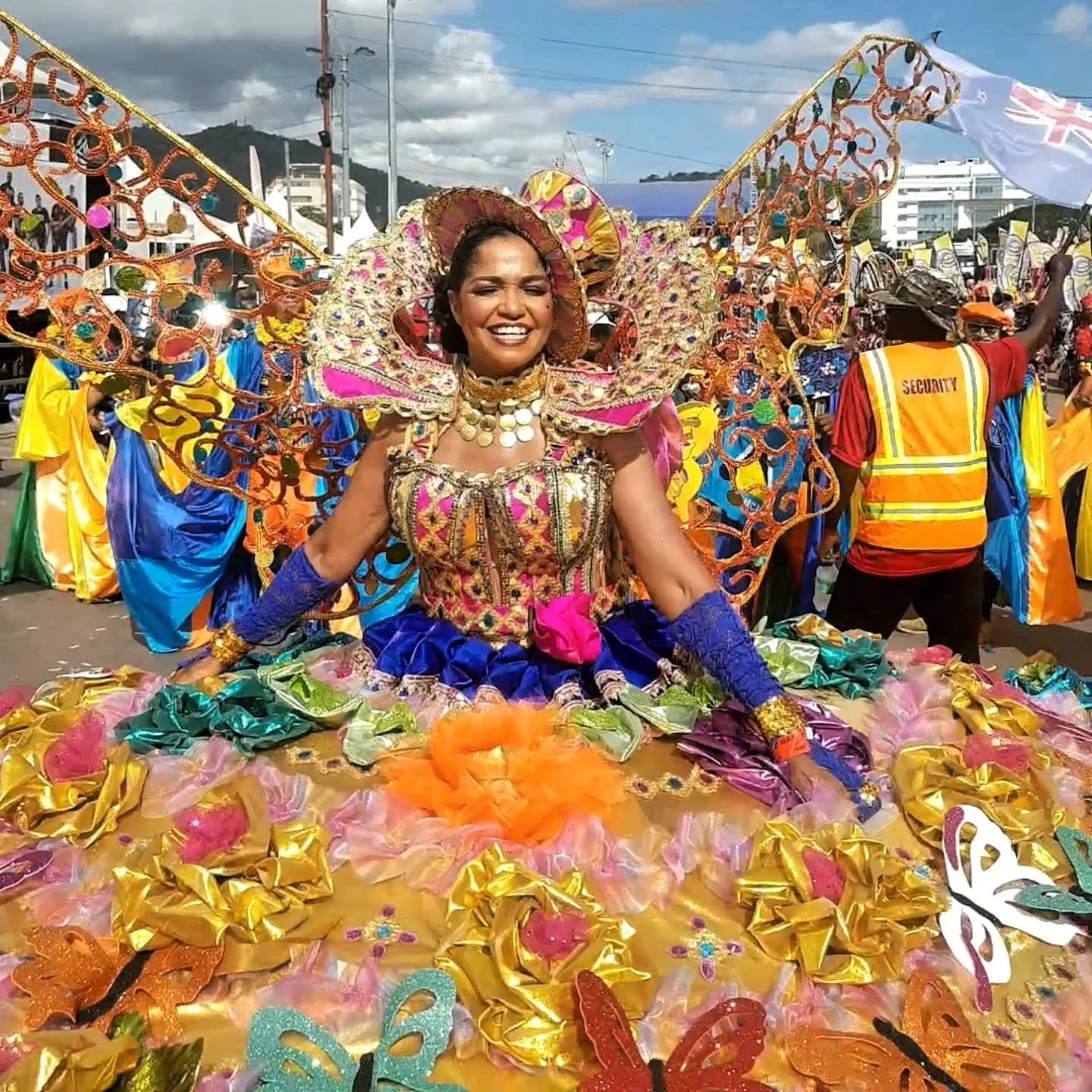A Carnival JUNCTION
What will our future carnivals look like?
5 min read
A masquerader from the band Kinetic Mas on Carnival Tuesday at the Queen’s Park Savannah.
(Image courtesy The National Carnival Commission of Trinidad and Tobago)
“Not a band, nor a mas is around to perform. All I can see is some broken old bottles so far, an indication the carnival is over!” - Lord Kitchener, The Carnival is Over, 1979.
And that’s a wrap! The most important few days in Trinidad and Tobago just ended. If you’re in other locations like Haiti, Dominica, Brazil, New Orleans, Malta and Cologne, the same rings true: Carnival is over! In the past few days, these countries and cities erupted in a climax of colour, creativity and celebration. But for Trinidad’s Carnival, which we boastfully refer to by several terms like The Greatest Show on Earth, The Mother of All Carnivals and The Carnival Mecca, we’re at an interesting juncture of determining where our carnival should go as cultural values continue to shift over time.
I wasn’t back home for the festivities this year, but I had been heavily consuming it digitally with every reel, status updates from friends and family, and live streaming of events. Whilst doing so, I also wrapped up relistening interviews I did for last year’s carnival as part of my PhD data collection, speaking to over 40 carnival practitioners and producers from almost every sector you can think of: traditional mas, pretty mas, j’ouvert, calypso, steelpan, legal and security, local government, regional carnival, tourism and fete promoters; the very popular and the barely known. With my brain pondering their views on the current state of our carnival, their hopes and aspirations, I’m also processing what I’ve seen online and heard from those who took part this year.
Suppose you’re new to this Trinidad Carnival space. In that case, one of the most vocalised thoughts of late is that it has gotten too expensive on several fronts, becoming a ‘bourgeois carnival’ mainly catering to the needs of both local and foreign middle and upper classes. This ‘bourgeois carnival’ might include securing costly flights and hotel rooms, attending the most sought after fetes and playing mas with the most popular carnival and j’ouvert bands. The knee jerk reaction is that everyone is greedy, but I beg to differ. I’ll always say that carnival does not happen in a vacuum, and global market trends, materials, pricing, and good ole capitalism supply and demand, have impacted the cost of many things within carnival, from costume production to steelpan transportation. You’d be surprised that leading entrepreneurs and businesses may generate little profit, break even or incur debt each season, as carnival venture management is not for the weak. However, I’m not denying that there isn’t money to be earned, that there aren’t major earners or that greed does not exist. Additionally, creative and cultural artists ought to have a decent livelihood from their skills and art, demonstrating that these are legitimate careers in the Caribbean. But our current juncture in carnival goes beyond this.
Sailor Masquerader. Maria Nunes Photography 2025.
We’ve gone through various eras of carnival, and naturally so. But dare I say that the last 15-20 years have really come to be riddled by gatekeeping which may beg of you to have connections to register to play mas and buy fete tickets. It’s also been defined by the dominance of the all-inclusive, premiere and luxury experiences of carnival - now at a place where there’s competition to ‘out-luxury’ each other and even oneself. Is it inherently wrong for carnival to have these elements? Absolutely not. Our carnival history shows us that the plantation and governor’s balls were here from inception catering to their audience, and given our society's postcolonial plantocracy influenced socio-economic strata, that isn’t about to change. Event management and audience studies will tell you that we may like to think a specific event is ‘for everyone’, but a target audience ought to be identified. So, while our overall carnival can have varying types of events, which it does, the seemingly underrepresented more grassroots style and easier accessible events that were known in the recent past are a cause of contention. It’s the motive for your specified audience or service, which we can call into question or challenge.
When people say that “carnival is not what it used to be,” it’s often times primarily rooted in the carnival era just before and after independence, that has been dubbed “The Golden Age” of carnival when pretty mas became more popular, replacing the ole’ mas style costumes with more professionalised artistic portrayals of recognisable themes. We often fail to go beyond this period to the transgressive Jamette Carnival era of the late 1800s, looking a bit deeper to understand that carnival has constantly been shaped and influenced by a myriad of circumstances. From the infamous Canboulay Riot of 1881, merchant class sponsorship of carnival competitions in the early 1900s, World War II with the presence of foreign sailors birthing sailor mas and the government of a newly independent nation using the festival as a political tool to shape a national identity.
While carnival brings people together, builds community and fosters nation building pride, it’s a fallacy to believe that this is the only thing it does, as this is a fantastic selling point for tourism and funding. The reality is that the festival has always been a double-edged sword and its own conundrum, that also highlights social tensions, dating back to its existence in Europe where the aristocrats and peasants converged. What carnival does rather, is subconsciously hold up a mirror to these existing tensions, allowing us to respond by either suspending, expelling or holding onto how we really feel about them. It’s something we often rather not acknowledge given that it’s a celebration rooted in freedom and joy. No one really likes engaging in difficult and uncomfortable conversations, least of all we're accused of bringing bad vibes, which feels like a total contradiction of what carnival is about. It’s for this very reason why it’s so difficult to address these matters head on, reflect and strategically think about what we truly want and need from varied carnival experiences.
A masquerader from the Ronnie and Caro band crosses the Savannah stage on Carnival Tuesday.
(Image courtesy The National Carnival Commission of Trinidad and Tobago)
It seems evident though, from the response of Carry It by Bunji Garlin, and the staging of his Hard Fete event, that there’s a desire to experience the grassroots feel of carnival, which represents a simplicity of showing up as oneself to have unadulterated fun. To not succumb to pressures of digital media content creation through our time filming events on our phones, putting on our Sunday best and more concerned about event decor and the food and liquor options. Now don’t get me wrong, there is an element of carnival that should celebrate us wanting to look and feel good and enjoy ‘nice things’. I won’t ever tell someone how to spend their money, just as I won’t let someone tell me how to spend mine. But the narrative we’ve been facing within this era is that the most meaningful way to enjoy carnival is to engage in specific offerings and experiences. The spaces and places that provide an alternative are often not popular with the vibes they once had, as with the large ‘public fetes’ that Bunji has sung about in Hard Fete, Carry It, and his 2017 soca called 1995.
We’ve embraced the newer services and experiences that undoubtedly have helped us to feel more refreshed, energised and see a much needed value for money from the ‘bourgeois carnival’. Influenced by global festival and entertainment spaces, there’s been more visually improved stage designs and on the road amenities that cater to practicality and functionality. However, what’s needed more than anything to determine what comes to define our next era of carnival, is a sense of agency by every single carnival producer, participant and lover. We’ve seen this agency with Bunji by him vocalising his feelings through songs about the change of the fete experience. He then took it a step further by introducing an event that can give such. Whilst easier said than done, it will also take participants to actively support alternatives if they truly desire and yearn for something else. Just like how any small business and entrepreneur needs that direct support from customers and a fan base, so too we can contribute to changing what is the dominant narrative of our carnival, as well as supporting the cultural heritage of our festival. Maybe we’ve forgotten that, just like the Canboulay rioters, participants too can have game-changing agency.
So, what are the cultural values of carnival that are important to you, and how do you want future carnivals to be known and experienced? The outcome rests in all of our hands. Choose wisely.
Written by
Kearn Christopher
The Karnival Czar



